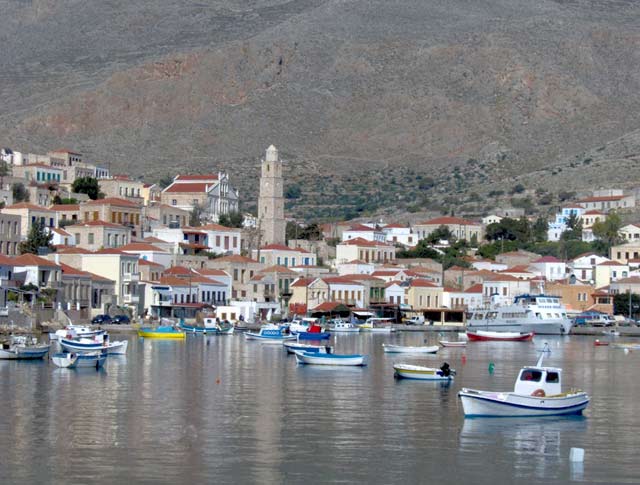This is to announce that I will not be blogging for a while. I may even stop blogging definitely. At least from Mosaicology. The reasons are plenty. First, I want to focus on my family and my work as a translator. Second, keeping this blog leads me nowhere especially as a mosaic artist since my life choices impede me from making any artistic work at the moment. I no longer believe in substitutes. This blog was a substitute and sadly it took me a while to realise that. I may be back but not in the form of what Mosaicology has been. Something new.
Those that follow me on Twitter will be advised of a new twitter account if I decide to create one (I think I might cause I love Twitter).
To stay in touch or if you are interested in my translation services (including anything related to mosaics) email me at magdamosaico@gmail.com
Monday, January 16, 2012
Friday, January 13, 2012
The magnificent pebble mosaics on Chalki island in Greece and the island's connection to Tarpon Springs in Florida, USA !!!?
How is it possible that you "stumble upon" an island?
This is what happened to me while researching about Kastelorizo, the "limestone" island. Chalki is close to Kastelorizo, belonging to the Dodecanese group of Greek islands.
On Chalki island you can admire some of the world's finest pebble mosaics. Unfortunately the few images I found on internet have copyright but if you go to this gallery HERE on Flickr you will see what I mean.
Now, what's more about this little island ? Many of its inhabitants have immigrated to Florida and established a sponge fishing business there!
Chalki (Halki) Island lies 16 km from Rhodes and 302 nautical miles from Piraeus. One of Greece's smallest islands it has 28 sq. km of land mass and 34 km of coastline. It has a population of under 300. No cars are allowed on the island. The capital and port of Nimborio is built ampitheatrically on the SE side of the island and on the Bay of Nimborio. Many of the inhabitants have immigrated to Tarpon Springs, Florida and established a sponge fishing enterprise there. Thats why the road from the main town and port is called Tarpon Springs Blvd., in honor of the immigrants who financed its construction. Beaches on both the north and south coasts are reached from the capital on foot or by caique of which Kania, Areta, Giali and Trachia are the nicest. 15 minutes walk along the 'blvd.' brings you to sandy Pondamos Beach with its taverna and umbrellas. Nimborio's Church of St. Nicolas with its important wall paintings and magnificent pebble mosais courtyard is the island's main attraction. The former capital Hora was inland to escape marauding pirates and is now deserted. In its heyday there were some 4000 residents. The ruined medeival castle was built on the site of the ancient acropolis. There are 3 monasteries on the island: Taxiarch Michael of St. John, Holy Trinity and Holy Cross.
More spectacular pebble mosaics from Chalki HERE
Quoted text from holiday-in-athens
Read more about Tarpon Springs HERE
Images link to their source
Wednesday, January 11, 2012
Romera Mosaic Vegetable Dish
 |
| image credit Katy McLaughlin |
Read more about chef and neurologist Romera HERE and HERE. Romera restaurant website HERE
Wednesday, January 4, 2012
Chi è la più bella del reame? (Who's the most beautiful of all?)
This is not the first time I feature a mosaic mirror on Mosaicology. Mosaic mirrors are a particular case as they combine small dimension, art and functionality in ways that no other medium can. Why? Only mosaic can "play" with the reflections of light. And this mirror here is the perfect demonstration of this. Notice the glimmering effect of the golden tiles and tell me if this can be achieved by another artistic medium (oops, does that sound too challenging?)
This stunning mirror is a work by mosaic artist Ariel, one of my twitter followers. She has two children.
This mosaic stands out for the wise combination of colours and the curved surface that makes this mirror an absolute stunner for your wall in any room of the house but especially the bedroom considering the combination of dark tiles and shiny ones that would add sparkle to a dimly lit room.
The tiles she used are of various sizes and she has managed to achieve wonderful light reflections by setting the tesserae (tiles) on a curved surface. This is an intelligent way to actually "make up for" the compromised effect of a mosaic made the direct way where there's no play with light. The Byzantines made spectacular glimmering mosaic vaults and walls in their basilicas because they mastered the technique of setting the tesserae (tiles) in ways to reflect light from the windows.
I have a penchant for anything unusual as long as it's pleasing to the senses and provided it embodies the aesthetic values that we have inherited throughout the ages. This mosaic fits the pattern.
I hope you will like this mirror as much as I do. Comments more than welcome. I will make sure Ariel gets them!
Ariel's website HERE
Tuesday, January 3, 2012
Sybil Sage, a comedy writer and mosaic maker
This is a NY Times article back from October 2010 that I am happy to share with you.
Sybil Sage, a veteran television comedy writer (for “The Mary Tyler Moore Show,” “Maude,” “Alice” and other gems from the written age), had been making objects with pique assiette — a French mosaic technique using broken plates — for years as a hobby, whacking china into shards to put on frames, vases and furniture for friends like Gene Wilder, Teri Garr, Lily Tomlin and Larry Merchant.
Read the whole article from the New York Times here
Subscribe to:
Comments (Atom)





